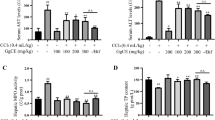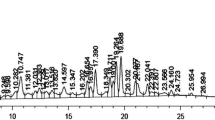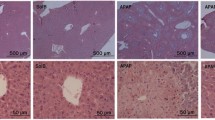Abstract
Monosodium glutamate (MSG), a commonly used flavor enhancer, has been reported to induce hepatic and renal dysfunctions. In this study, the palliative role of protocatechuic acid (PCA) in MSG-administered rats was elucidated. Adult male rats were assigned to four groups, namely control, MSG (4 g/kg), PCA (100 mg/kg), and the last group was co-administered MSG and PCA at aforementioned doses for 7 days. Results showed that MSG augmented the hepatic and renal functions markers as well as glucose, triglycerides, total cholesterol, and low-density lipoprotein levels. Moreover, marked increases in malondialdehyde levels accompanied by declines in glutathione levels and notable decreases in the activities of superoxide dismutase, catalase, glutathione peroxidase, and glutathione reductase were observed in MSG-treated group. The MSG-mediated oxidative stress was further confirmed by downregulation of nuclear factor erythroid 2–related factor 2 (Nrf2) gene expression levels in both tissues. In addition, MSG enhanced the hepatorenal inflammation as witnessed by increased inflammatory cytokines (interleukin-1b and tumor necrosis factor-α) and elevated nuclear factor-κB (NF-κB) levels. Further, significant increases in Bcl-2-associated X protein (Bax) levels together with decreases in B-cell lymphoma 2 (Bcl-2) levels were observed in MSG administration. Histopathological screening supported the biochemical and molecular findings. In contrast, co-treatment of rats with PCA resulted in remarkable enhancement of the antioxidant cellular capacity, suppression of inflammatory mediators, and apoptosis. These effects are possibly endorsed for activation of Nrf-2 and suppression of NF-kB signaling pathways. Collectively, addition of PCA counteracted MSG-induced hepatorenal injuries through modulation of oxidative, inflammatory and apoptotic alterations.







Similar content being viewed by others
Data availability
Available upon request.
References
Abdel Baky NA, Mohamed AM, Faddah LM (2009) Protective effect of N-acetyl cysteine and/or pro vitamin a against monosodium glutamate-induced cardiopathy in rats. J Pharmacol Toxicol 4:178–193
Abdel-Daim MM, Abo-EL-Sooud K, Aleya L, Bungǎu SG, Najda A, Saluja R (2018) Alleviation of drugs and chemicals toxicity: biomedical value of antioxidants. Oxidative Medicine and Cellular Longevity 6276438. https://doi.org/10.1155/2018/6276438
Acar A (n.d.) Ameliorative effects of cape gooseberry (Physalis peruviana L.) against monosodium glutamate (MSG)–induced toxicity: genetic and biochemical approach. Environ Sci Pollut Res 28(14):18035–18049
Adefegha SA, Omojokun OS, Oboh G (2015) Modulatory effect of protocatechuic acid on cadmium induced nephrotoxicity and hepatoxicity in rats in vivo. Springerplus 4:1–7
Aebi H (1984) Catalase in vitro. Methods Enzymol 105:121–126
Al Aboud D, Baty RS, Alsharif KF, Hassan KE, Zhery AS, Habotta OA, Elmahallawy EK, Amin HK, Moneim AEA, Kassab RB (2021) Protective efficacy of thymoquinone or ebselen separately against arsenic-induced hepatotoxicity in rat. Environ Sci Pollut Res 28:6195–6206
Al Olayan EM, Aloufi AS, AlAmri OD, El-Habit OH, Abdel Moneim AE (2020) Protocatechuic acid mitigates cadmium-induced neurotoxicity in rats: role of oxidative stress, inflammation and apoptosis. Sci Total Environ 723:137969
Albarakati AJA, Baty RS, Aljoudi AM, Habotta OA, Elmahallawy EK, Kassab RB, Moneim AEA (2020) Luteolin protects against lead acetate-induced nephrotoxicity through antioxidant, anti-inflammatory, anti-apoptotic, and Nrf2/HO-1 signaling pathways. Mol Biol Rep 47:2591–2603. https://doi.org/10.1007/s11033-020-05346-1
Albrahim T, Binobead MA (2018) Roles of Moringa oleifera leaf extract in improving the impact of high dietary intake of monosodium glutamate-induced liver toxicity, oxidative stress, genotoxicity, DNA damage, and PCNA alterations in male rats. Oxidative Med Cell Longev 2018:1–11
Allain CC, Poon LS, Chan CS, Richmond W, Fu PC (1974) Enzymatic determination of total serum cholesterol. Clin Chem 20:470–475
Al-Megrin WA, Alkhuriji AF, Yousef AOS, Metwally DM, Habotta OA, Kassab RB, Abdel Moneim AE, El-Khadragy MF (2020) Antagonistic efficacy of luteolin against lead acetate exposure-associated with hepatotoxicity is mediated via antioxidant, anti-inflammatory, and anti-apoptotic activities. Antioxidants 9:10
Banerjee A, Das D, Paul R, Roy S, Das U, Saha S, Dey S, Adhikary A, Mukherjee S, Maji BK (2020) Mechanistic study of attenuation of monosodium glutamate mixed high lipid diet induced systemic damage in rats by Coccinia grandis. Sci Rep 10:1–24
Celestino M, Valdez VB, Brun P, Castagliuolo I, Mucignat-Caretta C (2021) Differential effects of sodium chloride and monosodium glutamate on kidney of adult and aging mice. Sci Rep 11:481
del Carmen CM, Fabro A, Millen N, Benmelej A, Mahieu S (2017) Adverse effects in kidney function, antioxidant systems and histopathology in rats receiving monosodium glutamate diet. Exp Toxicol Pathol 69:547–556
Dixit SG, Rani P, Anand A, Khatri K, Chauhan R, Bharihoke V (2014) To study the effect of monosodium glutamate on histomorphometry of cortex of kidney in adult albino rats. Ren Fail 36:266–270
Eid RA, Al-Shraim M, Zaki MS, Kamar SS, Abdel Latif NS, Negm S, Al-Ani B, Haidara MA (2019) Vitamin E protects against monosodium glutamate-induced acute liver injury and hepatocyte ultrastructural alterations in rats. Ultrastruct Pathol 43:199–208
Elbassuoni EA, Ragy MM, Ahmed SM (2018) Evidence of the protective effect of l-arginine and vitamin D against monosodium glutamate-induced liver and kidney dysfunction in rats. Biomed Pharmacother 108:799–808
El-Khadragy MF, Al-Megrin WA, Alomar S, Alkhuriji AF, Metwally DM, Mahgoub S, Amin HK, Habotta OA, Moneim AEA, Albeltagy RS (2021) Chlorogenic acid abates male reproductive dysfunction in arsenic-exposed mice via attenuation of testicular oxido-inflammatory stress and apoptotic responses. Chem Biol Interact 333:109333
Ellman GL (1959) Tissue sulfhydryl groups. Arch Biochem Biophys 82:70–77
El-Sonbaty YA, Suddek GM, Megahed N, Gameil NM (2019) Protocatechuic acid exhibits hepatoprotective, vasculoprotective, antioxidant and insulin-like effects in dexamethasone-induced insulin-resistant rats. Biochimie 167:119–134
Factor VM, Kiss A, Woitach JT, Wirth PJ, Thorgeirsson SS (1998) Disruption of redox homeostasis in the transforming growth factor-alpha/c-myc transgenic mouse model of accelerated hepatocarcinogenesis. J Biol Chem 273:15846–15853
Farombi EO, Adedara IA, Awoyemi OV, Njoku CR, Micah GO, Esogwa CU, Owumi SE, Olopade JO (2016) Dietary protocatechuic acid ameliorates dextran sulphate sodium-induced ulcerative colitis and hepatotoxicity in rats. Food Funct 7:913–921
Fawcett J, Scott J (1960) A rapid and precise method for the determination of urea. J Clin Pathol 13:156–159
Fossati P, Prencipe L (1982) Serum triglycerides determined colorimetrically with an enzyme that produces hydrogen peroxide. Clin Chem 28:2077–2080
Gao W, Xiao C, Hu J, Chen B, Wang C, Cui B, Deng P, Yang J, Deng Z (2018) Qing brick tea (QBT) aqueous extract protects monosodium glutamate-induced obese mice against metabolic syndrome and involves up-regulation transcription factor nuclear factor-erythroid 2-related factor 2 (Nrf2) antioxidant pathway. Biomed Pharmacother 103:637–644
Geha RS, Beiser A, Ren C, Patterson R, Greenberger PA, Grammer LC, Ditto AM, Harris KE, Shaughnessy MA, Yarnold PR (2000) Review of alleged reaction to monosodium glutamate and outcome of a multicenter double-blind placebo-controlled study. J Nutr 130:1058S–1062S
Gill SS, Pulido OM (2001) Glutamate receptors in peripheral tissues: current knowledge, future research, and implications for toxicology. Toxicol Pathol 29:208–223
Guan S, Jiang B, Bao YM, An LJ (2006) Protocatechuic acid suppresses MPP+ -induced mitochondrial dysfunction and apoptotic cell death in PC12 cells. Food Chem Toxicol 44:1659–1666
Harini R, Pugalendi KV (2010) Antioxidant and antihyperlipidaemic activity of protocatechuic acid on streptozotocindiabetic rats. Redox Rep 15:71–80
Hassan HA, El-Kholy WM, El-Sawi MR, Galal NA, Ramadan MF (2020) Myrtle (Myrtus communis) leaf extract suppresses hepatotoxicity induced by monosodium glutamate and acrylamide through obstructing apoptosis, DNA fragmentation, and cell cycle arrest. Environ Sci Pollut Res 27:23188–23198
Ibegbulem CO, Chikezie PC, Ukoha AI, Opara CN (2016) Effects of diet containing monosodium glutamate on organ weights, acute blood steroidal sex hormone levels, lipid profile and erythrocyte antioxidant enzymes activities of rats. J Acute Dis 5:402–407
Ibitoye O, Ajiboye T (2020) Protocatechuic acid protects against menadione-induced liver damage by up-regulating nuclear erythroid-related factor 2. Drug Chem Toxicol 43:567–573
Jalali O, Best M, Wong A, Schaeffer B, Bauer B, Johnson L (2020) Reduced bacterial burden of the skin surrounding the shoulder joint following topical protocatechuic acid application: results of a pilot study. JB JS Open Access 5(3):e19.00078. https://doi.org/10.2106/JBJS.OA.19.00078
Kaewmool C, Kongtawelert P, Phitak T, Pothacharoen P, Udomruk S (2020) Protocatechuic acid inhibits inflammatory responses in LPS-activated BV2 microglia via regulating SIRT1/NF-κB pathway contributed to the suppression of microglial activation-induced PC12 cell apoptosis. J Neuroimmunol 341:577164
Kassab RB, Lokman MS, Daabo HMA, Gaber DA, Habotta OA, Hafez MM, Zhery AS, Moneim AEA, Fouda MS (2020) Ferulic acid influences Nrf2 activation to restore testicular tissue from cadmium-induced oxidative challenge, inflammation, and apoptosis in rats. J Food Biochem 44:e13505
Lende AB, Kshirsagar AD, Deshpande AD, Muley MM, Patil RR, Bafna PA, Naik SR (2011) Anti-inflammatory and analgesic activity of protocatechuic acid in rats and mice. Inflammopharmacology 19:255–263
Li L, Liu S, Tang H, Song S, Lu L, Zhang P, Li X (2020) Effects of protocatechuic acid on ameliorating lipid profiles and cardio-protection against coronary artery disease in high fat and fructose diet fed in rats. J Vet Med Sci 82:1387–1394
Li Z, Liu Y, Wang F, Gao Z, Elhefny MA, Habotta OA, Abdel Moneim AE, Kassab RB (2021) Neuroprotective effects of protocatechuic acid on sodium arsenate induced toxicity in mice: Role of oxidative stress, inflammation, and apoptosis. Chem Biol Interact 337:109392
Lin C-Y, Tsai S-J, Huang C-S, Yin M-C (2011) Antiglycative effects of protocatechuic acid in the kidneys of diabetic mice. J Agric Food Chem 59:5117–5124
Liu YM, Jiang B, Bao YM, An LJ (2008) Protocatechuic acid inhibits apoptosis by mitochondrial dysfunction in rotenone-induced PC12 cells. Toxicol In Vitro: an international journal published in association with BIBRA 22:430–437
Mahieu S, Klug M, Millen N, Fabro A, Benmelej A, del Carmen CM (2016) Monosodium glutamate intake affect the function of the kidney through NMDA receptor. Life Sci 149:114–119
Mekkawy AM, Ahmed YH, El-Sakhawy MA (2020) Ameliorative effect of Nigella sativa oil and vitamin C on the thyroid gland and cerebellum of adult male albino rats exposed to Monosodium glutamate (histological, immunohistochemical and biochemical studies). Tissue Cell 66:101391
Mirzakhani N, Farshid AA, Tamaddonfard E, Tehrani A, Imani M (2020) Comparison of the effects of hydroalcoholic extract of Capparis spinosa fruit, quercetin and vitamin E on monosodium glutamate-induced toxicity in rats. Vet Res Forum: an international quarterly journal 11:127–134
Molehin OR, Adeyanju AA, Adefegha SA, Oyeyemi AO, Idowu KA (2019) Protective mechanisms of protocatechuic acid against doxorubicin-induced nephrotoxicity in rat model. J Basic Clin Physiol Pharmacol 30(4). https://doi.org/10.1515/jbcpp-2018-0191
Nahok K, Li JV, Phetcharaburanin J, Abdul H, Wongkham C, Thanan R, Silsirivanit A, Anutrakulchai S, Selmi C, Cha’on U (2019) Monosodium glutamate (MSG) renders alkalinizing properties and its urinary metabolic markers of MSG consumption in rats. Biomolecules 9:542
Ohkawa H, Ohishi N, Yagi K (1979) Assay for lipid peroxides in animal tissues by thiobarbituric acid reaction. Anal Biochem 95:351–358
Onaolapo OJ, Onaolapo AY, Akanmu M, Gbola O (2016) Evidence of alterations in brain structure and antioxidant status following ‘low-dose’ monosodium glutamate ingestion. Pathophysiology 23:147–156
Ormazabal P, Scazzocchio B, Varì R, Santangelo C, D’Archivio M, Silecchia G, Iacovelli A, Giovannini C, Masella R (2018) Effect of protocatechuic acid on insulin responsiveness and inflammation in visceral adipose tissue from obese individuals: possible role for PTP1B. Int J Obes 42:2012–2021
Owumi S, Ajijola I, Agbeti O (2019) Hepatorenal protective effects of protocatechuic acid in rats administered with anticancer drug methotrexate. Hum Exp Toxicol 38:1254–1265
Paglia DE, Valentine WN (1967) Studies on the quantitative and qualitative characterization of erythrocyte glutathione peroxidase. J Lab Clin Med 70:158–169
Pfaffl MW (2001) A new mathematical model for relative quantification in real-time RT-PCR. Nucleic Acids Res 29:e45–e445
Radhiga T, Sundaresan A, Viswanathan P, Pugalendi KV (2016) Effect of protocatechuic acid on lipid profile and DNA damage in D-galactosamine-induced hepatotoxic rats. J Basic Clin Physiol Pharmacol 27:505–514
Reitman S, Frankel S (1957) A colorimetric method for the determination of serum glutamic oxalacetic and glutamic pyruvic transaminases. Am J Clin Pathol 28:56–63
Roman-Ramos R, Almanza-Perez JC, Garcia-Macedo R, Blancas-Flores G, Fortis-Barrera A, Jasso EI, Garcia-Lorenzana M, Campos-Sepulveda AE, Cruz M, Alarcon-Aguilar FJ (2011) Monosodium glutamate neonatal intoxication associated with obesity in adult stage is characterized by chronic inflammation and increased mRNA expression of peroxisome proliferator-activated receptors in mice. Basic Clin Pharmacol Toxicol 108:406–413
Sasaki Y, Shimada T, Iizuka S, Suzuki W, Makihara H, Teraoka R, Tsuneyama K, Hokao R, Aburada M (2011) Effects of bezafibrate in nonalcoholic steatohepatitis model mice with monosodium glutamate-induced metabolic syndrome. Eur J Pharmacol 662:1–8
Schirmeister J (1964) Determination of creatinine in serum. Dtsch Med Wschr 89:1018–23. https://doi.org/10.1055/s-0028-1111251
Seiva FR, Chuffa LGA, Braga CP, Amorim JPA, Fernandes AAH (2012) Quercetin ameliorates glucose and lipid metabolism and improves antioxidant status in postnatally monosodium glutamate-induced metabolic alterations. Food Chem Toxicol 50:3556–3561
Sharma A (2015) Monosodium glutamate-induced oxidative kidney damage and possible mechanisms: a mini-review. J Biomed Sci 22:1–6
Sharma A, Wongkham C, Prasongwattana V, Boonnate P, Thanan R, Reungjui S, Cha’on U (2014) Proteomic analysis of kidney in rats chronically exposed to monosodium glutamate. PLoS One 9:e116233
Shukry M, El-Shehawi AM, El-Kholy WM, Elsisy RA, Hamoda HS, Tohamy HG, Abumandour MM, Farrag FA (2020) Ameliorative effect of graviola (Annona muricata) on mono sodium glutamate-induced hepatic injury in rats: antioxidant, apoptotic, anti-inflammatory, lipogenesis markers, and histopathological studies. Animals 10:1996
Song J, He Y, Luo C, Feng B, Ran F, Xu H, Ci Z, Xu R, Han L, Zhang D (2020) New progress in the pharmacology of protocatechuic acid: a compound ingested in daily foods and herbs frequently and heavily. Pharmacol Res 161:105109
Sun Y, Oberley LW, Li Y (1988) A simple method for clinical assay of superoxide dismutase. Clin Chem 34:497–500
Trinder P (1969) Determination of glucose in blood using glucose oxidase with an alternative oxygen acceptor. Ann Clin Biochem 6:24–27
Varì R, D’Archivio M, Filesi C, Carotenuto S, Scazzocchio B, Santangelo C, Giovannini C, Masella R (2011) Protocatechuic acid induces antioxidant/detoxifying enzyme expression through JNK-mediated Nrf2 activation in murine macrophages. J Nutr Biochem 22:409–417
Williams A, Woessner K (2009) Monosodium glutamate ‘allergy’: menace or myth? Clin Exp Allergy 39:640–646
Xi Z, Chen X, Xu C, Wang B, Zhong Z, Sun Q, Sun Y, Bian L (2020) Protocatechuic acid attenuates brain edema and blood-brain barrier disruption after intracerebral hemorrhage in mice by promoting Nrf2/HO-1 pathway. Neuroreport 31:1274–1282
Xu L, Sun J, Lu R, Ji Q, Xu J-G (2005) Effect of glutamate on inflammatory responses of intestine and brain after focal cerebral ischemia. World J Gastroenterol: WJG 11:733
Ya F, Li K, Chen H, Tian Z, Fan D, Shi Y, Song F, Xu X, Ling W, Adili R, Yang Y (2021) Protocatechuic acid protects platelets from apoptosis via inhibiting oxidative stress-mediated PI3K/Akt/GSK3β signaling. Thromb Haemost 121:931–943
Yin X, Zhang X, Lv C, Li C, Yu Y, Wang X, Han F (2015) Protocatechuic acid ameliorates neurocognitive functions impairment induced by chronic intermittent hypoxia. Sci Rep 5:14507
Yuan X, Fu Z, Ji P, Guo L, Al-Ghamdy AO, Alkandiri A, Habotta OA, Abdel Moneim AE, Kassab RB (2020) Selenium nanoparticles pre-treatment reverse behavioral, oxidative damage, neuronal loss and neurochemical alterations in pentylenetetrazole-induced epileptic seizures in mice. Int J Nanomedicine 15:6339–6353
Zanfirescu A, Ungurianu A, Tsatsakis AM, Nițulescu GM, Kouretas D, Veskoukis A, Tsoukalas D, Engin AB, Aschner M, Margină D (2019) A review of the alleged health hazards of monosodium glutamate. Compr Rev Food Sci Food Saf 18:1111–1134
Zhang HN, An CN, Zhang HN, Pu XP (2010) Protocatechuic acid inhibits neurotoxicity induced by MPTP in vivo. Neurosci Lett 474:99–103
Funding
This work was supported by Taif University Researchers Supporting Program (Project number: TURSP-2020/153), Taif University, Saudi Arabia.
Author information
Authors and Affiliations
Contributions
Maha S. Lokman, Rami B. Kassab, Ali O. Al-Ghamdy, and Abdulrahman Theyab: animal treatments, biochemical, and methodology; Ahmad H. Mufti, Mohammad Algahtani, Ehab M. Abdella, and Ola A. Habotta: visualization, investigation, and histological examinations; Khalaf F. Alsharif, Maha A. Alshiekheid, and Ashraf Albrakati: writing-reviewing and editing; Mohamed M. Omran, Amira A. Bauomy, Roua S. Baty, Khalid E. Hassan, Ahmed E. Abdel Moneim, and Heba A. Elmasry: conceptualization, validation, and supervision. All authors participated in the design, interpretation of the studies, and analysis of the data and review of the manuscript.
Corresponding author
Ethics declarations
Ethics approval
All procedures were performed following the policies and guidelines of the Committee of Research Ethics for Laboratory Animal Care, Faculty of Science, Department of Zoology, Helwan University (Cairo, Egypt; Permit Number: HU2020/Z/RKA1020-03).
Consent to participate
Not applicable.
Consent to publish
Consented.
Conflict of interest
The author declares no competing interest.
Additional information
Responsible editor: Mohamed M. Abdel-Daim
Publisher’s note
Springer Nature remains neutral with regard to jurisdictional claims in published maps and institutional affiliations.
Rights and permissions
About this article
Cite this article
Kassab, R.B., Theyab, A., Al-Ghamdy, A.O. et al. Protocatechuic acid abrogates oxidative insults, inflammation, and apoptosis in liver and kidney associated with monosodium glutamate intoxication in rats. Environ Sci Pollut Res 29, 12208–12221 (2022). https://doi.org/10.1007/s11356-021-16578-4
Received:
Accepted:
Published:
Issue Date:
DOI: https://doi.org/10.1007/s11356-021-16578-4




